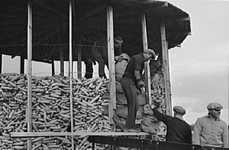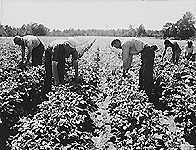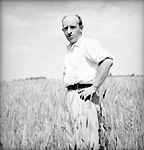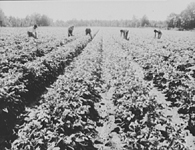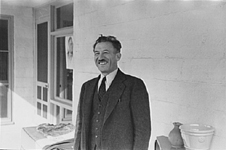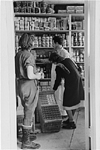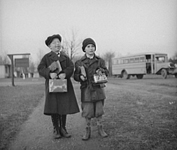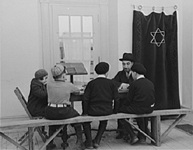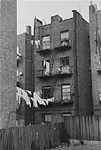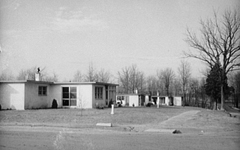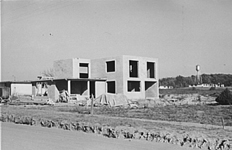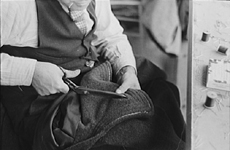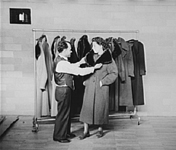Notes on the History of Arthur Shapiro, Ed.D. Black
and white photographs referenced from this page Return to Natural, Historic, and Social Resources page. The Borough of Roosevelt, located in western Monmouth County, was originally called Jersey Homesteads. It was established in 1936 under the auspices of the United States government, as an agricultural-industrial cooperative community for Jewish garment workers and farmers. As such, it was one of President Franklin Delano Roosevelt's experiments to find ways of dealing with the social and economic distress caused by the Great Depression.
In 1937, Jersey Homesteads separated from Millstone Township and was incorporated as a borough. The town is now designated on both the State and National Registers of Historic Places as the Jersey Homesteads Historic District. Interest in the community of Roosevelt has been great and resulted in several dissertations, countless newspaper and magazine articles, books, a film, and an exhibit devoted to its history, architecture, and culture at the New Jersey State Museum.
The founder of Jersey Homesteads was Benjamin Brown, an immigrant from Russia who had established Jewish agricultural cooperatives in the West. In addition to founding the town, his contribution to Jewish causes include the use of his farm four miles from Roosevelt by the World Zionist Organization to train pioneers for work on the farms of Israel upon its establishment as a nation. Interestingly, several young men on Brown's farm who took flying lessons at a local airport (Robbinsville) became the first pilots of the Israeli Air Force.
Brown envisioned Jersey Homesteads as a model for many similar communities in which Eastern European Jewish culture and the Yiddish language could be preserved. Albert Einstein was among the many prominent members of the Jewish community who supported the project during its difficult beginnings.
The community was constructed under an innovative plan that clustered the houses and left common open space in the middle of each block. The buildings, designed by Alfred Kastner were in the highly functional Bauhaus style first used in Germany in the 1920s. One of Kastner's associates was the now famous Louis I. Kahn.
The cooperative garment factory and farms lasted only a few years; and, after the Second World War, the government sold the homes to the residents (or other buyers) and the factory to private owners of a company that manufactured hats. The name of the town was changed to Roosevelt in 1954 to honor the deceased president. Ever since 1936, when Ben and Bernarda Shahn came to town to create the mural that graces the Roosevelt Public School, the community has attracted artists. Among other prominent artists who have lived in Roosevelt are Gregorio Prestopino; David Stone Martin and his son, Stefan Martin; Jacob Landau; Robert Mueller; and the Shahns' son Jonathan Shahn. The Roosevelt Arts Project, an organization of local artists, writers, musicians, and poets, holds a series of exhibitions and performances every year. Among the interesting individuals who lived in the town was the Rev. John Grauel, the only non-Jew and non-refugee who lived aboard the ship Exodus among 4,500 passengers on a ship built to hold 600. In addition, Rev. Grauel was a member of the Haganah, the Jewish underground, and was later one of the foremost Christian clergymen to testify before the United Nations on behalf of the establishment of the state of Israel. Although a headstone has been placed in the Roosevelt community cemetery in his honor, he is buried in Israel as one of its heroes. Roosevelt today is a safe, quite community with fewer than 900 residents. It is still the only town in the United States that has a synagogue as its single house of worship. The community has no police or home mail delivery. (It is protected by the New Jersey State Police.) It is surrounded by farms, open spaces, and a state wildlife management area. In addition, the town has a strong tradition of community involvement and democratic participation. While recognizing that some additional development may be inevitable, the residents of Roosevelt are strongly committed to maintaining the distinctive character of their community for future generations. At its meeting of May 13, 1999, the borough council adopted an ordinance creating the Jersey Homesteads Historic District Advisory Council, chaired by a member, to be designated by the mayor, with the statutory title of Local Historian. The mission of the Council is to educate the public regarding the history of Roosevelt and its significance in the history of Monmouth County and New Jersey. Dr. Arthur Shapiro, a life-long resident of Roosevelt was named to the chair. About the author. Dr. Shapiro is a life-long resident of the town and, currently, a professor of Special Education at Kean University. He began his teaching career in the Roosevelt Public School, which both he and his children attended. He has served in the Borough Council, the Volunteer Fire Department, and the town band. He is currently working on a book on the community and the shared experiences of growing up there. Return to Natural, Historic, and Social Resources page. Created 31 October 1999. |

